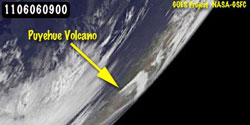3 satellites see eruption of Puyehue-Cordón volcano from space

GOES-11 satellite image, taken on June 6 at 0900 UTC (5 a.m. EDT) from the farthest vantage point of any of the satellites, still showed the triangular-shaped plume, even from its position over the western US, despite the large distance. Credit: NASA/NOAA GOES Project, Dennis Chesters<br>
The Terra satellite flew over the volcano on June 6 at 14:25 UTC (10:25 a.m. EDT). The Moderate Resolution Imaging Spectroradiometer (MODIS) instrument captured a visible image of the eruption that showed the large ash plume blowing northeast, then to the southeast and over the Atlantic Ocean. The ash plume went at least as high as six miles on June 4 when it erupted, according to CNN International. Some 3,500 people were evacuated.
The Geostationary Operational Environmental Satellites called GOES-13 and GOES-11 also captured images of the volcano from a different vantage point in space that revealed the plume was visible from even farther away.
GOES-13 monitors the eastern U.S. and the Atlantic Ocean, while GOES-11 monitors the western U.S. and eastern Pacific Ocean. The GOES-11 satellite image, taken from the farthest vantage point of any of the satellites, still showed the triangular-shaped plume, even from its position over the western U.S., despite the large distance.
The GOES satellites are managed by NOAA, and imagery and animations are created with the GOES satellite data at NASA's GOES Project located at NASA's Goddard Space Flight Center, Greenbelt, Md.
Media Contact
More Information:
http://www.nasa.govAll latest news from the category: Earth Sciences
Earth Sciences (also referred to as Geosciences), which deals with basic issues surrounding our planet, plays a vital role in the area of energy and raw materials supply.
Earth Sciences comprises subjects such as geology, geography, geological informatics, paleontology, mineralogy, petrography, crystallography, geophysics, geodesy, glaciology, cartography, photogrammetry, meteorology and seismology, early-warning systems, earthquake research and polar research.
Newest articles

High-energy-density aqueous battery based on halogen multi-electron transfer
Traditional non-aqueous lithium-ion batteries have a high energy density, but their safety is compromised due to the flammable organic electrolytes they utilize. Aqueous batteries use water as the solvent for…

First-ever combined heart pump and pig kidney transplant
…gives new hope to patient with terminal illness. Surgeons at NYU Langone Health performed the first-ever combined mechanical heart pump and gene-edited pig kidney transplant surgery in a 54-year-old woman…

Biophysics: Testing how well biomarkers work
LMU researchers have developed a method to determine how reliably target proteins can be labeled using super-resolution fluorescence microscopy. Modern microscopy techniques make it possible to examine the inner workings…





















